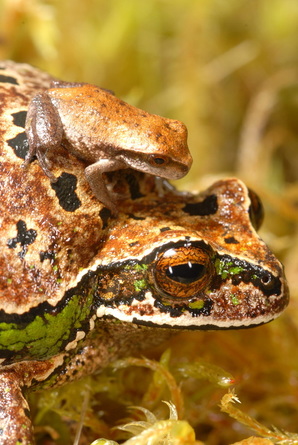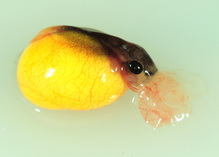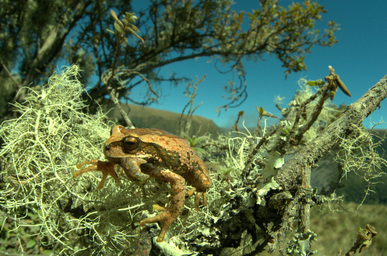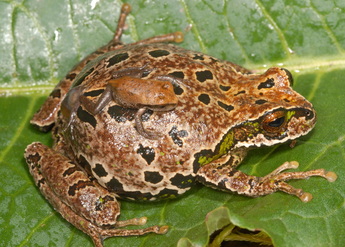



 A new lab contribution published today in Biology Letters documents for the first time the occurrence of maternal nutrient transfer to embryos developing in the dorsal pouch in marsupial frogs. These Central and South American hemiphractid frogs (genus Gastrotheca) reproduce like no other frog. The female lays eggs externally and the male fertilizes them, but unlike any other frog he then introduces the eggs into the female’s dorsal brooding pouch. In this protected environment, embryos develop until hatching either as tadpoles, or, in the majority of species, as fully developed and miniature versions of the adults - such as the young Gastrotheca excubitor in this picture. The ancestral condition in this group is direct development, and marsupial frogs are the only group of frogs in which species laying feeding tadpoles have evolved from direct developing ancestors, with reversal to direct development in some derived species.  The embryos of the most derived marsupial frogs have gigantic bell-shaped gills, a unique characteristic only shared with other genera in the family. These modified gills likely play an important role in acquiring maternally derived nutrients during embryonic development. Our new study, which is a collaboration with our colleague Robin Warne, provides two lines of evidence supporting the idea that mothers provide nutrients to embryos.  First, brooding females were fed with isotopically enriched prey. Each prey was sprinkled with an amino acid high in δ15N and a fatty acid high in δ13C. We were then able to track this isotopic enrichment in the tissues of the mother, as well as the tissues of the developing embryos. The isotopic enrichment in 15N embryos increased non-linearly with development, suggesting that amino acid demand increases with development in rapidly growing embryos and then declines near metamorphosis.  The second line of evidence is that embryo dry mass increased with developmental stage. Earlier researchers had hypothesized that the large gills of marsupial frog embryos might allow exchange of nutrients, and measured embryo mass change in tadpole-laying species without finding evidence of such exchange. Our findings in direct-developing Gastrotheca excubitor show that ancestral features for gas exchange for developing embryos may indeed be co-opted for nutrient transfer, and provide insight into the evolution of matrotrophy in vertebrates.
4 Comments
María Teresa Sandoval
10/26/2016 03:45:31 pm
Deseo recibir una copia del trabajo. Muchas gracias!
Reply
Sandra Fernandez
10/27/2016 09:36:03 am
Me gustaria recibir el texo completo del trabajo, gracias!!
Reply
Leave a Reply. |
Archives
June 2024
CATENAZZI LABNews from the lab Categories |